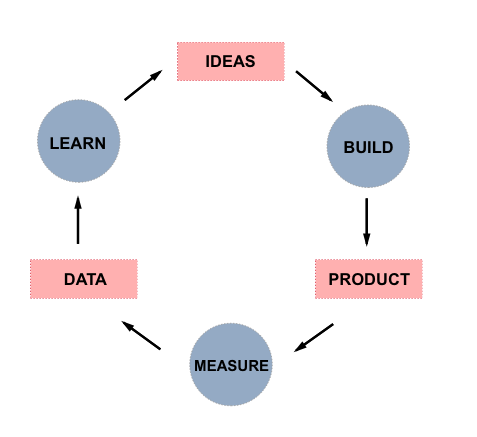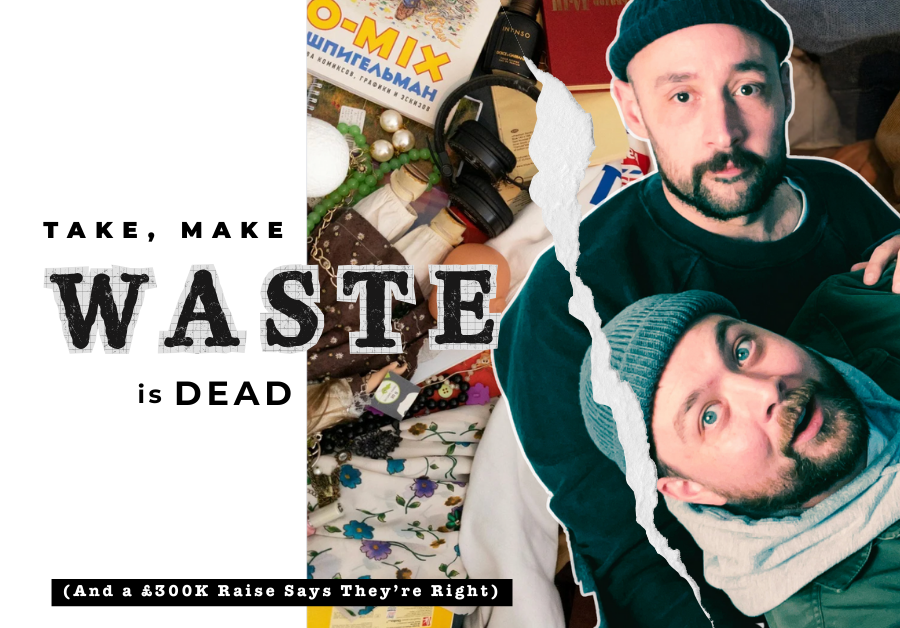Starting a new project can be thrilling, and you might be tempted to dive right in and create the ultimate product that you think will change the world. But will your target audience share your vision?
The Lean Startup methodology, particularly the Build-Measure-Learn cycle, is a process for creating successful digital projects by discovering what your users need, identifying potential problems, and testing your ideas with the people you aim to serve.
This article explores the key components of the Build-Measure-Learn feedback loop and how it can help guide your digital product development towards success.
In this article, we’ll cover the following:
➡️ How Build-Measure-Learn fits into the Lean Startup methodology
➡️ A typical Build-Measure-Learn process
➡️ An example of how to apply a Build-Measure-Learn cycle
➡️ The benefits of using this approach in your product development process
The Origins of the Lean Startup Methodology
The Build-Measure-Learn method forms part of the Lean Startup approach.
When starting a business, the chances are your strategy goes as follows: have an idea, write a business plan, build a product, and then try to sell it to customers. What could go wrong?
The short answer is a lot! 3 out of 4 new businesses fail. Businesses are regularly started based on untested assumptions, so it makes sense that most of them will fail.
This is where the Lean Startup approach comes into play. It’s a radical departure from traditional approaches to starting a business. The “Lean Startup” movement began in Silicon Valley in the early 2000s and was popularised by two entrepreneurs, Steve Blank and Eric Ries.
💡 Often, the Lean Startup methodology is attributed to Eric Ries; however, it’s based on a few different books:
📚 The Four Steps to the Epiphany by Steve Blank (2003)
📚 Business Model Generationby Alexander Osterwalder and Yves Pigneur (2010)
📚 The Lean Startup by Eric Ries (2011)
📚 The Startup Owner’s Manual by Steve Blank and Bob Dorf (2012)
The Lean Startup method was specifically developed for software development and launching digital products in uncertain conditions. So, this fits the description for virtually all tech startups.
The Key Principals of the Lean Startup Method
Here are the key principles of the Lean Startup methodology:
💡 Entrepreneurs are everywhere
You don’t have to work in Silicon Valley to be an entrepreneur. Anyone can be an entrepreneur, regardless of background, education, or economic status.
Entrepreneurship is a mindset and a way of solving problems. It’s about creating value by solving problems and addressing customer needs.
💡 Entrepreneurship requires managing uncertainty
In a startup, traditional management approaches – focusing on planning, forecasting, and executing a rigid, predefined plan – don’t work.
In a startup’s fast-paced, uncertain, and rapidly changing environment, the focus must be on managing uncertainty, learning from experimentation, and adapting to new information and feedback.
💡 Innovation accounting
In a Lean Startup, the goal is to create a product that customers want. There have been many products brought to market that nobody was interested in. Remember Yik Yak and Quibi?
Lean Startups avoid product failures like the ones above.
Eric Ries calls this “innovation accounting”, which he defines as a disciplined way of determining whether a product comes closer to satisfying customers’ needs.
💡 Validated learning
A key principle of Lean methodology is that startups should fail fast and learn fast. With a lean startup, failing isn’t necessarily a failure. Negative feedback is regarded as learning and represents a path towards improving the product.
Learning is at the core of the Lean method. As we’ve mentioned above, this method is about building products customers want.
Instead of spending months developing a product and then waiting for feedback, Lean Startups are constantly iterating. This is done through a process called “validated learning”.
💡 Finally, the Build-Measure-Learn Cycle
The Build-Measure-Learn loop is one of the core components of the Lean Startup methodology.
Steve Blank defines the Build-Measure-Learn cycle as:
“Build a product, get it into the real world, measure customers’ reactions and behaviours, learn from this, and use what you’ve learned to build something better. Repeat, learning whether to iterate, pivot or restart until you have something customers love”.
The following section will explore the Build-Measure-Learn method in detail.
A Typical Build-Measure-Learn Cycle

Build
Technically, creating a successful product begins with an idea (or hypothesis) that states that a product will address a problem or resonate with a specific audience.
Next, the building phase will start. During the Build process, the team focuses on creating a minimum viable product (MVP) quickly and efficiently, using the least resources possible. It’s important to note that the MVP is not a finished product with fewer features.
Instead, the minimum viable product focuses on the product’s core features that provide the customer with the most value. It’s a small but functional product version that your users trial run, allowing you to quickly test assumptions and gather feedback.
These insights are then used to improve the product in the next step of the Build-Measure-Learn cycle.
💡 What Does an MVP Look Like?
It depends on the growth stage of your startup. If you are in the early stages, your MVP could be a physical prototype, wireframe, clay model, or sample data set. If you are in the growth stages, your MVP might include adding new features to expand your product.
A great example is Dropbox. Dropbox’s first MVP was a short video explaining how the product worked. As a result, Dropbox got tens of thousands of subscribers overnight. These early adopters shaped the direction of the product we know today.
By using the Build-Measure-Learn loop, Dropbox gradually developed requested features – for example, integrating their tool with Microsoft Office.
Today, the company has over 500 million users worldwide, and its net worth is estimated at $10 billion.
In the build phase, the goal is not to create a fully functional product. Instead, it’s about continuously making incremental progress using feedback and data.
Measure
The next step in the Build-Measure-Learn loop is to measure the performance of the MVP by collecting data and user feedback. This phase involves running experiments, conducting surveys, or analysing user behaviour and metrics.
The moment of truth arrives when you critically examine the data and explore how customers respond to your product.
Identify which metrics matter most
First, identify which metrics you want to measure. These metrics need to be actionable and provide insight into how your product is performing and how to improve it.
For example, if your goal is to increase customer engagement, you should track monthly active users or average time spent on the site. Other metrics include things like conversion rates, retention rates, and customer acquisition costs.
Collect the data
Once you have identified the right metrics, you must determine the methods to measure them. Eric Ries suggests that Lean Startups conduct activities such as split tests, real-time monitoring, funnel analysis, cohort analysis, and search engine marketing, to name a few.
Remember, the goal when collecting data is to gather actionable information to inform future decisions and iterations of the product. So, keep it specific and don’t collect mountains of data you don’t know what to do with.
Learn
In the Learn phase of the Lean Startup methodology, the goal is to take the data collected from the Measure phase and use it to make informed decisions about the future direction of the product or service.
This process involves a few steps:
Analyse your data
Identify patterns and trends, and pinpoint areas of the product that need improvement. Explore what happened, the implications, and if your hypothesis was correct.
Draw insight
The Learn phase of the Build-Measure-Learn loop also involves either validating or invalidating the assumptions made during the Build phase. It’s the time when you decide what is next. If your hypothesis is correct, you apply the Build-Measure-Learn process to the next step of your MVP.
Sometimes, after this process, you gather evidence showing your idea was incorrect and you now have to pivot and rethink your offering. While it’s tough to accept that it doesn’t work, you will save a lot of time and money in the long run.
Pivoting is a natural part of the Lean methodology as it allows startups to adapt to new information and stay on track towards creating a successful product.
This method will enable you to return to the drawing board, formulate a new or amended hypothesis, and then Build again – the cycle continues.
Data Presentation
An overlooked aspect of the Learn phase is sharing your findings and insights with stakeholders.
Tell a compelling story with the data. There is a dual purpose for this. First, you will keep your team engaged and aligned on the next steps by presenting your findings in an attention-grabbing way. Second, it looks good for potential investors to see meaningful progress.
An Example of How Build-Measure-Learn Works
To bring the Build-Measure-Learn approach to life, we’ve devised a practical example to show you how a startup could use the Build-Measure-Learn loop.
Let’s say a startup wants to create a meal delivery subscription service specialising in healthy and organic meals. Usually, the process would go like this:
➡️ A founder would have a big idea and write down their business plan.
➡️ Next, they would create their website and app on paper.
➡️ The next part of the process is to hire a team to develop the product. In this case, to keep it simple, let’s say they need a tech team to develop the code, chefs to create recipes, and teams to procure food and organise logistics.
➡️ Once the product is complete, the next step is to market the service and find customers.
A large upfront investment will now be needed for something that might not work. Here’s how they could use the Build-Measure-Learn method instead:
🛠️ Build: The startup creates a business plan that outlines its unique value proposition and customer base. They then design their MVP – a landing page to showcase their service.
📊 Measure: The startup asks potential customers for feedback on which features and benefits they want in the meal subscription service. They do a competitor analysis to refine their pricing strategy.
📚 Learn: Based on customer feedback and market analysis, the startup learns customers are interested in a customisable meal plan. They also learn that the pricing is too high for most customers, and they must offer more flexible pricing options.
🛠️ Build: The startup redesigns its website; instead of offering set packages, customers can choose which meals they want. They also add a new pricing tier. They then create a prototype and test it with a small group of customers.
📊 Measure: The startup collects customer feedback on the prototype by analysing data on order volume, customer satisfaction, and revenue. They also conduct A/B testing on their website landing pages and app to optimise the user experience.
📚 Learn: Based on the feedback and data collected, the startup learns that customers love the customisable meal plan, and the new pricing tier is more attractive. However, they also learn that delivery times must be faster and more reliable.
🛠️ Build: The startup improves its logistics and delivery system to offer faster and more reliable delivery. They also launch a new marketing campaign to attract more customers.
📊 Measure: The startup continues collecting data on customer orders, satisfaction, and revenue, as well as analysing trends and identifying areas for improvement.
📚 Learn: Based on ongoing feedback and data, the startup learns how to refine its service and grow its customer base, building a successful and sustainable business.
This process continues as the startup iterates to create an offering that solves a particular pain point for its target market.
The Benefits of Using a Build-Measure-Learn Approach
Now that you know what Lean Startup methodology is, let’s examine the benefits it can offer your business. The benefits for startups include:
🏆 Reduced risk
Starting a business is taking a step into the unknown. With a Lean approach, you are not betting everything on the accuracy of your assumptions.
By focusing on building a minimum viable product (MVP) quickly and testing it with real customers, you’re gathering performance data to guide you. This process minimises the risk of investing too much time and resources in a product that may not be successful in the market.
🏆 Faster time to market
The Build-Measure-Learn approach emphasises speed and agility in product development, allowing startups to launch products more quickly.
🏆 Cost-effective
Creating an MVP uses fewer resources, meaning a startup needs less funding to start a project. Also, by testing features with customers, startups can save money and avoid investing in features that may not be important to customers.
🏆 Flexibility
The Lean methodology allows startups to pivot or change direction quickly based on feedback from the market rather than being locked into a particular course of action.
Build-Measure-Learn Key Takeaways
The Build-Measure-Learn approach (and, by extension, the Lean Startup methodology) is an excellent alternative to the traditional hit-or-miss approach to starting a business.
This technique considers the uncertainty of startups and provides a framework for owners to quickly develop and refine a product while minimising risks and costs.
By making customer feedback the key driver of product development, the Build-Measure-Learn method increases your chances of creating a product that customers will buy.
MOHARA Can Help
We’re a product venture studio with over ten years of experience developing software for startups.
We have helped more than 30 pioneering startups bring successful software products to market, so we understand the product development process from start to finish.
So if you have a great business idea, we can help you build an MVP using our version of Build-Measure-Learn and enable you to launch your product successfully.
Why not get in touch with us and see how we can help you with your MVP development process?
Let’s be pioneers together!
Starting a new project can be thrilling, and you might be tempted to dive right in and create the ultimate product that you think will change the world. But will your target audience share your vision?
The Lean Startup methodology, particularly the Build-Measure-Learn cycle, is a process for creating successful digital projects by discovering what your users need, identifying potential problems, and testing your ideas with the people you aim to serve.
This article explores the key components of the Build-Measure-Learn feedback loop and how it can help guide your digital product development towards success.
In this article, we’ll cover the following:
➡️ How Build-Measure-Learn fits into the Lean Startup methodology
➡️ A typical Build-Measure-Learn process
➡️ An example of how to apply a Build-Measure-Learn cycle
➡️ The benefits of using this approach in your product development process
The Origins of the Lean Startup Methodology
The Build-Measure-Learn method forms part of the Lean Startup approach.
When starting a business, the chances are your strategy goes as follows: have an idea, write a business plan, build a product, and then try to sell it to customers. What could go wrong?
The short answer is a lot! 3 out of 4 new businesses fail. Businesses are regularly started based on untested assumptions, so it makes sense that most of them will fail.
This is where the Lean Startup approach comes into play. It’s a radical departure from traditional approaches to starting a business. The “Lean Startup” movement began in Silicon Valley in the early 2000s and was popularised by two entrepreneurs, Steve Blank and Eric Ries.
💡 Often, the Lean Startup methodology is attributed to Eric Ries; however, it’s based on a few different books:
📚 The Four Steps to the Epiphany by Steve Blank (2003)
📚 Business Model Generationby Alexander Osterwalder and Yves Pigneur (2010)
📚 The Lean Startup by Eric Ries (2011)
📚 The Startup Owner’s Manual by Steve Blank and Bob Dorf (2012)
The Lean Startup method was specifically developed for software development and launching digital products in uncertain conditions. So, this fits the description for virtually all tech startups.
The Key Principals of the Lean Startup Method
Here are the key principles of the Lean Startup methodology:
💡 Entrepreneurs are everywhere
You don’t have to work in Silicon Valley to be an entrepreneur. Anyone can be an entrepreneur, regardless of background, education, or economic status.
Entrepreneurship is a mindset and a way of solving problems. It’s about creating value by solving problems and addressing customer needs.
💡 Entrepreneurship requires managing uncertainty
In a startup, traditional management approaches – focusing on planning, forecasting, and executing a rigid, predefined plan – don’t work.
In a startup’s fast-paced, uncertain, and rapidly changing environment, the focus must be on managing uncertainty, learning from experimentation, and adapting to new information and feedback.
💡 Innovation accounting
In a Lean Startup, the goal is to create a product that customers want. There have been many products brought to market that nobody was interested in. Remember Yik Yak and Quibi?
Lean Startups avoid product failures like the ones above.
Eric Ries calls this “innovation accounting”, which he defines as a disciplined way of determining whether a product comes closer to satisfying customers’ needs.
💡 Validated learning
A key principle of Lean methodology is that startups should fail fast and learn fast. With a lean startup, failing isn’t necessarily a failure. Negative feedback is regarded as learning and represents a path towards improving the product.
Learning is at the core of the Lean method. As we’ve mentioned above, this method is about building products customers want.
Instead of spending months developing a product and then waiting for feedback, Lean Startups are constantly iterating. This is done through a process called “validated learning”.
💡 Finally, the Build-Measure-Learn Cycle
The Build-Measure-Learn loop is one of the core components of the Lean Startup methodology.
Steve Blank defines the Build-Measure-Learn cycle as:
“Build a product, get it into the real world, measure customers’ reactions and behaviours, learn from this, and use what you’ve learned to build something better. Repeat, learning whether to iterate, pivot or restart until you have something customers love”.
The following section will explore the Build-Measure-Learn method in detail.
A Typical Build-Measure-Learn Cycle

Build
Technically, creating a successful product begins with an idea (or hypothesis) that states that a product will address a problem or resonate with a specific audience.
Next, the building phase will start. During the Build process, the team focuses on creating a minimum viable product (MVP) quickly and efficiently, using the least resources possible. It’s important to note that the MVP is not a finished product with fewer features.
Instead, the minimum viable product focuses on the product’s core features that provide the customer with the most value. It’s a small but functional product version that your users trial run, allowing you to quickly test assumptions and gather feedback.
These insights are then used to improve the product in the next step of the Build-Measure-Learn cycle.
💡 What Does an MVP Look Like?
It depends on the growth stage of your startup. If you are in the early stages, your MVP could be a physical prototype, wireframe, clay model, or sample data set. If you are in the growth stages, your MVP might include adding new features to expand your product.
A great example is Dropbox. Dropbox’s first MVP was a short video explaining how the product worked. As a result, Dropbox got tens of thousands of subscribers overnight. These early adopters shaped the direction of the product we know today.
By using the Build-Measure-Learn loop, Dropbox gradually developed requested features – for example, integrating their tool with Microsoft Office.
Today, the company has over 500 million users worldwide, and its net worth is estimated at $10 billion.
In the build phase, the goal is not to create a fully functional product. Instead, it’s about continuously making incremental progress using feedback and data.
Measure
The next step in the Build-Measure-Learn loop is to measure the performance of the MVP by collecting data and user feedback. This phase involves running experiments, conducting surveys, or analysing user behaviour and metrics.
The moment of truth arrives when you critically examine the data and explore how customers respond to your product.
Identify which metrics matter most
First, identify which metrics you want to measure. These metrics need to be actionable and provide insight into how your product is performing and how to improve it.
For example, if your goal is to increase customer engagement, you should track monthly active users or average time spent on the site. Other metrics include things like conversion rates, retention rates, and customer acquisition costs.
Collect the data
Once you have identified the right metrics, you must determine the methods to measure them. Eric Ries suggests that Lean Startups conduct activities such as split tests, real-time monitoring, funnel analysis, cohort analysis, and search engine marketing, to name a few.
Remember, the goal when collecting data is to gather actionable information to inform future decisions and iterations of the product. So, keep it specific and don’t collect mountains of data you don’t know what to do with.
Learn
In the Learn phase of the Lean Startup methodology, the goal is to take the data collected from the Measure phase and use it to make informed decisions about the future direction of the product or service.
This process involves a few steps:
Analyse your data
Identify patterns and trends, and pinpoint areas of the product that need improvement. Explore what happened, the implications, and if your hypothesis was correct.
Draw insight
The Learn phase of the Build-Measure-Learn loop also involves either validating or invalidating the assumptions made during the Build phase. It’s the time when you decide what is next. If your hypothesis is correct, you apply the Build-Measure-Learn process to the next step of your MVP.
Sometimes, after this process, you gather evidence showing your idea was incorrect and you now have to pivot and rethink your offering. While it’s tough to accept that it doesn’t work, you will save a lot of time and money in the long run.
Pivoting is a natural part of the Lean methodology as it allows startups to adapt to new information and stay on track towards creating a successful product.
This method will enable you to return to the drawing board, formulate a new or amended hypothesis, and then Build again – the cycle continues.
Data Presentation
An overlooked aspect of the Learn phase is sharing your findings and insights with stakeholders.
Tell a compelling story with the data. There is a dual purpose for this. First, you will keep your team engaged and aligned on the next steps by presenting your findings in an attention-grabbing way. Second, it looks good for potential investors to see meaningful progress.
An Example of How Build-Measure-Learn Works
To bring the Build-Measure-Learn approach to life, we’ve devised a practical example to show you how a startup could use the Build-Measure-Learn loop.
Let’s say a startup wants to create a meal delivery subscription service specialising in healthy and organic meals. Usually, the process would go like this:
➡️ A founder would have a big idea and write down their business plan.
➡️ Next, they would create their website and app on paper.
➡️ The next part of the process is to hire a team to develop the product. In this case, to keep it simple, let’s say they need a tech team to develop the code, chefs to create recipes, and teams to procure food and organise logistics.
➡️ Once the product is complete, the next step is to market the service and find customers.
A large upfront investment will now be needed for something that might not work. Here’s how they could use the Build-Measure-Learn method instead:
🛠️ Build: The startup creates a business plan that outlines its unique value proposition and customer base. They then design their MVP – a landing page to showcase their service.
📊 Measure: The startup asks potential customers for feedback on which features and benefits they want in the meal subscription service. They do a competitor analysis to refine their pricing strategy.
📚 Learn: Based on customer feedback and market analysis, the startup learns customers are interested in a customisable meal plan. They also learn that the pricing is too high for most customers, and they must offer more flexible pricing options.
🛠️ Build: The startup redesigns its website; instead of offering set packages, customers can choose which meals they want. They also add a new pricing tier. They then create a prototype and test it with a small group of customers.
📊 Measure: The startup collects customer feedback on the prototype by analysing data on order volume, customer satisfaction, and revenue. They also conduct A/B testing on their website landing pages and app to optimise the user experience.
📚 Learn: Based on the feedback and data collected, the startup learns that customers love the customisable meal plan, and the new pricing tier is more attractive. However, they also learn that delivery times must be faster and more reliable.
🛠️ Build: The startup improves its logistics and delivery system to offer faster and more reliable delivery. They also launch a new marketing campaign to attract more customers.
📊 Measure: The startup continues collecting data on customer orders, satisfaction, and revenue, as well as analysing trends and identifying areas for improvement.
📚 Learn: Based on ongoing feedback and data, the startup learns how to refine its service and grow its customer base, building a successful and sustainable business.
This process continues as the startup iterates to create an offering that solves a particular pain point for its target market.
The Benefits of Using a Build-Measure-Learn Approach
Now that you know what Lean Startup methodology is, let’s examine the benefits it can offer your business. The benefits for startups include:
🏆 Reduced risk
Starting a business is taking a step into the unknown. With a Lean approach, you are not betting everything on the accuracy of your assumptions.
By focusing on building a minimum viable product (MVP) quickly and testing it with real customers, you’re gathering performance data to guide you. This process minimises the risk of investing too much time and resources in a product that may not be successful in the market.
🏆 Faster time to market
The Build-Measure-Learn approach emphasises speed and agility in product development, allowing startups to launch products more quickly.
🏆 Cost-effective
Creating an MVP uses fewer resources, meaning a startup needs less funding to start a project. Also, by testing features with customers, startups can save money and avoid investing in features that may not be important to customers.
🏆 Flexibility
The Lean methodology allows startups to pivot or change direction quickly based on feedback from the market rather than being locked into a particular course of action.
Build-Measure-Learn Key Takeaways
The Build-Measure-Learn approach (and, by extension, the Lean Startup methodology) is an excellent alternative to the traditional hit-or-miss approach to starting a business.
This technique considers the uncertainty of startups and provides a framework for owners to quickly develop and refine a product while minimising risks and costs.
By making customer feedback the key driver of product development, the Build-Measure-Learn method increases your chances of creating a product that customers will buy.
MOHARA Can Help
We’re a product venture studio with over ten years of experience developing software for startups.
We have helped more than 30 pioneering startups bring successful software products to market, so we understand the product development process from start to finish.
So if you have a great business idea, we can help you build an MVP using our version of Build-Measure-Learn and enable you to launch your product successfully.
Why not get in touch with us and see how we can help you with your MVP development process?
Let’s be pioneers together!












